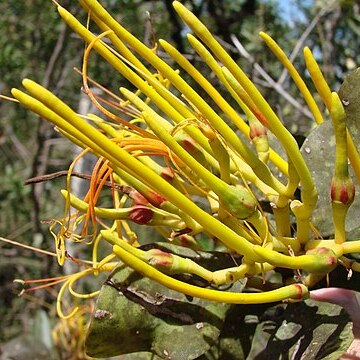Often large, leafy, glabrous parasites, primary haustorium massive; epicortical roots mostly lacking; stems terete or quadrangular. Leaves usually paired, sometimes whorled; blades often fleshy or leathery. Inflorescences indeterminate racemes or umbels of triads or dyads, former in terminal or subterminal positions, latter axillary. Flowers large, mostly pedicellate (sessile in P. cucullaris), subtended by 1 bract or bracteole each; bisexual, 6-merous, usually brightly colored in red or red and yellow; petals and stamens dimorphic, rarely isomorphic; petals long, slender, fused to varying length, bearing epipetalous stamens consisting of slender filaments, anthers dorsifixed, mostly versatile, 4-loculate. Fruit a large berry; seed consisting mostly of a massive, fleshy green seedling with 2 or more large, fleshy cotyledons, endosperm lacking. (x = 8, 10).
Always stout and erect shrubs, lacking aerial roots. Leaves usually opposite, coriaceous. Flowers large, showy, brilliantly colored, hexamerous, androgynous, in ternations or binations; these in racemes, corymbs or umbels; bractlets united in a cup which subtends the flowers. Tepals either free or connate, sometimes ligulate at the base. Stamens unequal, alternately shorter and longer, the filaments slender; pollen grains 3-angled, flattened, the exine granulose. Stigma capitate. Fruit baccate, large for the group, the seeds without endosperm but bearing big, and often more than 2, cotyledons.

